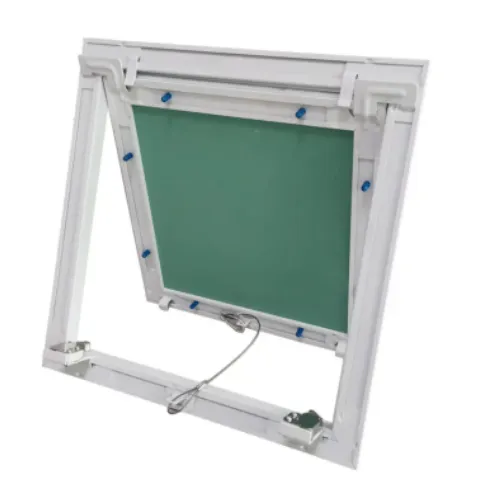- Afrikaans
- Albanian
- Amharic
- Arabic
- Armenian
- Azerbaijani
- Basque
- Belarusian
- Bengali
- Bosnian
- Bulgarian
- Catalan
- Cebuano
- Corsican
- Croatian
- Czech
- Danish
- Dutch
- English
- Esperanto
- Estonian
- French
- German
- Greek
- Hindi
- Indonesian
- irish
- Italian
- Japanese
- Korean
- Lao
- Malay
- Myanmar
- Norwegian
- Norwegian
- Polish
- Portuguese
- Romanian
- Russian
- Serbian
- Spanish
- Swedish
- Thai
- Turkish
- Ukrainian
- Uzbek
- Vietnamese
Lis . 12, 2024 04:09 Back to list
how to open ceiling access panel
How to Open a Ceiling Access Panel A Step-by-Step Guide
Ceiling access panels are integral components in many buildings, serving as entry points to areas like attics, ductwork, or plumbing systems that require periodic maintenance or inspection. Knowing how to properly open a ceiling access panel is essential for anyone looking to perform repairs, upgrades, or inspections in their home or workplace. This guide will walk you through the steps to safely and effectively open a ceiling access panel.
Step 1 Gather Necessary Tools
Before you begin, ensure you have the necessary tools handy. Depending on your access panel design, you may need
- A flathead screwdriver or a utility knife (for panels with a flush design) - A ladder (to safely reach the ceiling) - A flashlight (to illuminate the access area) - Personal protective equipment (such as safety glasses and gloves)
Step 2 Identify the Location of the Panel
Access panels are often strategically located in less visible areas, such as hallways, closets, or behind light fixtures. If you’re uncertain about where your access panel is located, look for signs of a removable section in the ceiling. These panels may be framed wood, metal, or drywall.
Step 3 Safety First
Before proceeding, ensure that the area around the access panel is clear of obstructions. If you’re working in an attic or similar environment, make sure you’re aware of any potential hazards. Confirm that any electrical systems or plumbing in the area are not live, if you plan to access these systems. Turning off the power at the circuit breaker is a prudent safety measure.
Step 4 Position the Ladder
If the access panel is high up in the ceiling, carefully position your ladder underneath it. Make sure the ladder is stable and on a flat surface, and avoid placing it in high-traffic areas where it may become a hazard. Use a stepladder if the panel is particularly high up to ensure you have full access and stability.
Step 5 Inspect the Panel
how to open ceiling access panel

Once you’re at the right height, examine the access panel closely. Some panels are designed with simple latch mechanisms, while others may be held in place with screws. Identify how it is secured, as this will dictate the method you use to open it.
Step 6 Open the Access Panel
If your access panel has latches, gently release them. If it’s secured with screws, use a screwdriver to remove them carefully. Be sure to keep the screws in a safe place to avoid losing them. For flush panels, gently pry the panel away from the ceiling using your flathead screwdriver or utility knife, taking care not to damage the surrounding area.
If you encounter resistance while trying to open the panel, don’t force it, as this could cause damage. Instead, check for any additional fasteners or obstructions.
Step 7 Use Caution When Accessing Inside
After the panel is open, be cautious as you inspect the area within. Use your flashlight to illuminate dark corners and look for any signs of damage, pests, or issues that might need attention. If you’re working with electrical wiring or plumbing, ensure that you’re well-informed about the system you’re dealing with, or consult a professional if needed.
Step 8 Closing the Panel
Once your inspection or maintenance is complete, carefully replace the access panel. Align it properly and secure it using the original fasteners or latches. Make sure it is closed tightly to prevent dust and pests from entering the area.
Step 9 Clean Up
After closing the panel, tidy up your workspace. Remove any tools and equipment, and ensure that your ladder is safely stored away. If you encountered any debris or dust during your inspection, take the time to clean it up, keeping the area safe and tidy for future access.
Conclusion
Opening a ceiling access panel is a straightforward task that can save you time and money when addressing maintenance issues. By following these steps, you can safely gain access to important areas within your home or business, ensuring that everything functions smoothly. Always prioritize safety and, when in doubt, don’t hesitate to seek professional help for complex systems.
-
Transform Interiors with PVC Gypsum Ceiling: A Stylish, Durable, and Moisture-Resistant SolutionNewsMay.19,2025
-
The Smart Interior Upgrade: Discover the Durability and Versatility of Gypsum Ceiling Access Panel SolutionsNewsMay.19,2025
-
The Smart Choice for Interior Design: Discover the Value of PVC Gypsum Ceiling SolutionsNewsMay.19,2025
-
Mineral Fiber Ceiling Tiles: The Smart Blend of Performance and AestheticsNewsMay.19,2025
-
Mineral Fiber Ceiling Tiles: The Superior Choice Over Gypsum for Sound and Fire SafetyNewsMay.19,2025
-
Mineral Fiber Ceiling Tiles: Eco-Friendly Strength and Style for Every CeilingNewsMay.19,2025







